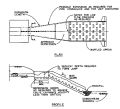Baffled Drop Examples: Difference between revisions
(Created page with "<!--Example Page --> <div style= "text-align:center;"> <!-- Add message here --> ''Message: Examples of Baffled Drops'' </div> ----</br> <!-- Add body paragraphs here --> Examples of baffled drops are shown in the photos below. Incoming flow is directed onto a row of spaced baffles. The flow is split again by a downstream second row of offset baffles. The flow encounters additional rows of baffles until the bottom of the drop is reached. The flow basically “tumbles”...") |
No edit summary |
||
| (One intermediate revision by the same user not shown) | |||
| Line 1: | Line 1: | ||
[[Category:Accounting for Energy Dissipation Outlet Works]] | |||
---- | |||
<!-- Add body paragraphs here --> | <!-- Add body paragraphs here --> | ||
Examples of baffled drops are shown in the photos below. Incoming flow is directed onto a row of spaced baffles. The flow is split again by a downstream second row of offset baffles. The flow encounters additional rows of baffles until the bottom of the drop is reached. The flow basically “tumbles” down the drop from baffle to baffle dissipating energy along the length of the chute. Because this “tumbling” dissipates the energy, exit velocities from the drop are low regardless of the tailwater elevation. Since a baffled drop does not require a specific tailwater elevation, it can be a viable potential energy dissipation option where tailwater elevation varies. | Examples of baffled drops are shown in the photos below. Incoming flow is directed onto a row of spaced baffles. The flow is split again by a downstream second row of offset baffles. The flow encounters additional rows of baffles until the bottom of the drop is reached. The flow basically “tumbles” down the drop from baffle to baffle dissipating energy along the length of the chute. Because this “tumbling” dissipates the energy, exit velocities from the drop are low regardless of the tailwater elevation. Since a baffled drop does not require a specific tailwater elevation, it can be a viable potential [[Energy Dissipation|energy dissipation]] option where tailwater elevation varies. | ||
<gallery mode="slideshow" > | <gallery mode="slideshow" > | ||
<!-- Add image files here --> | <!-- Add image files here --> | ||
| Line 12: | Line 9: | ||
File:BD2.jpg|Baffled Drop Plan and Profile. | File:BD2.jpg|Baffled Drop Plan and Profile. | ||
File:BD3.jpg|Baffled drop aerating the flow so that it becomes saturated. | File:BD3.jpg|Baffled drop aerating the flow so that it becomes saturated. | ||
File:BD4.jpg|Typical Bureau of Reclamation baffled drop layout. | File:BD4.jpg|Typical [[Bureau of Reclamation]] baffled drop layout. | ||
</gallery> | </gallery> | ||
''Note: The content on this page was originally created as part of DamOutletWorks.org (DOWL, 2018). It has subsequently been updated and reformatted as part of the Dam Safety Toolbox.'' | |||
[[Category:Example Pages]] | [[Category:Example Pages]] | ||
{{Revhistinf}} | {{Revhistinf}} | ||
Latest revision as of 03:29, 2 December 2022
Examples of baffled drops are shown in the photos below. Incoming flow is directed onto a row of spaced baffles. The flow is split again by a downstream second row of offset baffles. The flow encounters additional rows of baffles until the bottom of the drop is reached. The flow basically “tumbles” down the drop from baffle to baffle dissipating energy along the length of the chute. Because this “tumbling” dissipates the energy, exit velocities from the drop are low regardless of the tailwater elevation. Since a baffled drop does not require a specific tailwater elevation, it can be a viable potential energy dissipation option where tailwater elevation varies.
Note: The content on this page was originally created as part of DamOutletWorks.org (DOWL, 2018). It has subsequently been updated and reformatted as part of the Dam Safety Toolbox.
Revision ID: 4762
Revision Date: 12/02/2022




